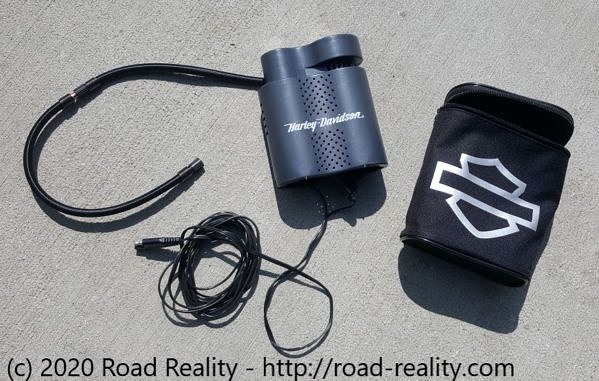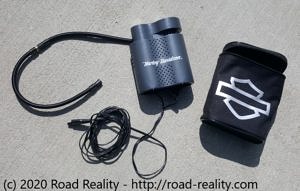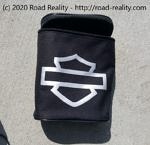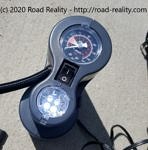
 Anyone who has gone through a Motorcycle Safety Foundation (MSF) course and gotten their motorcycle license is familiar with the T-CLOCS system. Literally the first item on the list is tires, and it can be a drag to check your tires, only to find they are several PSI low and your first stop will be a gas station or service center to fill them up. After seeing it used on a YouTube video, I wanted to check it out for myself, so I rode to my local Harley Davidson dealer and picked up this gadget: Harley’s Compact Air Compressor.
Anyone who has gone through a Motorcycle Safety Foundation (MSF) course and gotten their motorcycle license is familiar with the T-CLOCS system. Literally the first item on the list is tires, and it can be a drag to check your tires, only to find they are several PSI low and your first stop will be a gas station or service center to fill them up. After seeing it used on a YouTube video, I wanted to check it out for myself, so I rode to my local Harley Davidson dealer and picked up this gadget: Harley’s Compact Air Compressor.
 I was watching Million Dollar Bogan on YouTube, who needed to air up his Harley’s tires after off-roading it – yes, off-roading his Harley – and he struggled with CO2 canisters until he realized he had the HD air compressor on his bike. There he was, on the side of the road, filling up his tires. Even at home it looks like an incredibly easy way to check and top off the tires before even setting out – and it sure beats lugging around a 6lb pancake compressor, waiting for it to fill, filling up two skinny tires, and then putting it back in storage.
I was watching Million Dollar Bogan on YouTube, who needed to air up his Harley’s tires after off-roading it – yes, off-roading his Harley – and he struggled with CO2 canisters until he realized he had the HD air compressor on his bike. There he was, on the side of the road, filling up his tires. Even at home it looks like an incredibly easy way to check and top off the tires before even setting out – and it sure beats lugging around a 6lb pancake compressor, waiting for it to fill, filling up two skinny tires, and then putting it back in storage.
 After purchasing the air compressor (Part # 12700020 on Harley’s site, MSRP: $42.95 as of this post), I quickly rode home and checked it out. It comes packaged with its own carrying case, and includes the compressor, battery tender connector, tire valve stem connector and extension. The last part is particularly important, since some bikes have hard-to-reach valve stems, and the extension makes reaching them a cinch.
After purchasing the air compressor (Part # 12700020 on Harley’s site, MSRP: $42.95 as of this post), I quickly rode home and checked it out. It comes packaged with its own carrying case, and includes the compressor, battery tender connector, tire valve stem connector and extension. The last part is particularly important, since some bikes have hard-to-reach valve stems, and the extension makes reaching them a cinch.
 The unit itself doesn’t feel overly robust, but it’s not heavy, so it’s easy to put in a backpack, saddle bag, or tail bag. It’s not overly big, either, about the size of two well-made sandwiches. Its got Harley’s name in script on one side, the light and pressure gauge on the top, and a nice opening on the bottom to store the power cord, as well as built-in tabs to hold the valve stem connector in place when not in use.
The unit itself doesn’t feel overly robust, but it’s not heavy, so it’s easy to put in a backpack, saddle bag, or tail bag. It’s not overly big, either, about the size of two well-made sandwiches. Its got Harley’s name in script on one side, the light and pressure gauge on the top, and a nice opening on the bottom to store the power cord, as well as built-in tabs to hold the valve stem connector in place when not in use.
 If you’re like most riders, you’ve already installed a battery tender connector, and that’s where the brilliance of this unit shines – it runs off that. So long as your battery isn’t dead, it’ll power the air compressor, letting you fill your tires off the grid. What a concept!
If you’re like most riders, you’ve already installed a battery tender connector, and that’s where the brilliance of this unit shines – it runs off that. So long as your battery isn’t dead, it’ll power the air compressor, letting you fill your tires off the grid. What a concept!
 To use the compressor, just plug its power connector into your battery tender lead on your bike, screw on the valve stem connector, check the gauge, and flip the power button until the tire is filled to your liking. Every bike and tire combination has its recommended pressure, so it’s nice to see that the Harley compressor highlights 30 to 40 PSI, the general range for motorcycle tires. The built-in LED light also lets you find your valve stem in the dark, a handy feature.
To use the compressor, just plug its power connector into your battery tender lead on your bike, screw on the valve stem connector, check the gauge, and flip the power button until the tire is filled to your liking. Every bike and tire combination has its recommended pressure, so it’s nice to see that the Harley compressor highlights 30 to 40 PSI, the general range for motorcycle tires. The built-in LED light also lets you find your valve stem in the dark, a handy feature.
On its first use, I wanted to compare the Harley gauge to my fancy analog dial gauge. I like how my bikes handle given the readout on that gauge, so if the Harley one read the same, I knew I’d like it. Spoiler alert: it was spot-on! So far, I’ve used it on all four of our bikes, and it’s worked flawlessly. Our air temperatures have about a 25-degree swing, depending on the time of day, so it’s nice to know that I can quickly check the pressures and adjust as needed. It can be a little loud since it’s close to your ears during use, but it’s not enough to be bothersome.
 What don’t I like? Well, the LED light is a nice feature, but it’s aimed right in your eyes when you’re reading the gauge. I work around this by putting my hand over the light when I go to read the gauge. Its value at night in finding the valve stem has already proved itself, so it’s a minor trade-off. Also, the gauge is small and somewhat hard to read, but I get it – without moving the gauge to the side, it would be hard to fit a larger one.
What don’t I like? Well, the LED light is a nice feature, but it’s aimed right in your eyes when you’re reading the gauge. I work around this by putting my hand over the light when I go to read the gauge. Its value at night in finding the valve stem has already proved itself, so it’s a minor trade-off. Also, the gauge is small and somewhat hard to read, but I get it – without moving the gauge to the side, it would be hard to fit a larger one.
At $42.95, it’s not on a budget rider’s radar, but it sure packs a lot of convenience into a fairly small package. Being able to adjust pressures while on multi-day trips or in a condo/apartment situation where a portable air compressor just isn’t practical, but this unit is quite handy. I like this air compressor, and am glad I purchased it. I’m sure there are competitors to it on the market, so feel free to do some research if you don’t want something with the HD name on it (it didn’t seem to bother my Kawasakis to have a HD product plugged into them).
by John Suit
